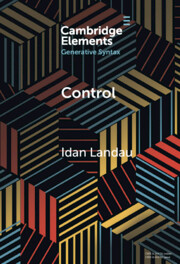Refine search
Actions for selected content:
6584 results in Grammar and Syntax

Modern Persian, Elementary Level
- beh farsi begoo
-
- Published by:
- Anthem Press
- Published online:
- 18 December 2024
- Print publication:
- 16 April 2024

Constructions and Compositionality
- Cognitive and Computational Explorations
-
- Published online:
- 17 December 2024
- Print publication:
- 30 January 2025
-
- Element
- Export citation

Control
-
- Published online:
- 03 December 2024
- Print publication:
- 09 January 2025
-
- Element
- Export citation

Language Change and Linguistic Diversity
- Studies in Honour of Lyle Campbell
-
- Published by:
- Edinburgh University Press
- Published online:
- 22 November 2024
- Print publication:
- 31 March 2022
3 - Cultivating the Value of Democracy in History Teaching
-
-
- Book:
- The Discourse of History
- Published online:
- 16 May 2024
- Print publication:
- 23 May 2024, pp 45-72
-
- Chapter
- Export citation
2 - Cultivating a Critical Gaze: Managing Technicality in Ancient History Teaching
-
-
- Book:
- The Discourse of History
- Published online:
- 16 May 2024
- Print publication:
- 23 May 2024, pp 16-44
-
- Chapter
- Export citation
References
-
- Book:
- The Discourse of History
- Published online:
- 16 May 2024
- Print publication:
- 23 May 2024, pp 322-337
-
- Chapter
- Export citation
6 - Explaining What Happened: Logical Metaphors in Spanish History Textbooks
-
-
- Book:
- The Discourse of History
- Published online:
- 16 May 2024
- Print publication:
- 23 May 2024, pp 116-144
-
- Chapter
- Export citation
5 - Coordinating Meaning: Scaffolding Teaching/Learning in Pedagogic Discourse
-
-
- Book:
- The Discourse of History
- Published online:
- 16 May 2024
- Print publication:
- 23 May 2024, pp 95-115
-
- Chapter
- Export citation
8 - Historical Empathy: Learning to Care about Others’ Suffering through Film
-
-
- Book:
- The Discourse of History
- Published online:
- 16 May 2024
- Print publication:
- 23 May 2024, pp 181-196
-
- Chapter
- Export citation
7 - Negotiating Values through Historical Evidence
-
-
- Book:
- The Discourse of History
- Published online:
- 16 May 2024
- Print publication:
- 23 May 2024, pp 145-180
-
- Chapter
- Export citation
Figures
-
- Book:
- The Discourse of History
- Published online:
- 16 May 2024
- Print publication:
- 23 May 2024, pp vii-viii
-
- Chapter
- Export citation
Copyright page
-
- Book:
- The Discourse of History
- Published online:
- 16 May 2024
- Print publication:
- 23 May 2024, pp iv-iv
-
- Chapter
- Export citation
Contents
-
- Book:
- The Discourse of History
- Published online:
- 16 May 2024
- Print publication:
- 23 May 2024, pp v-vi
-
- Chapter
- Export citation
9 - History in the Arts: Exploring the Past to Cultivate Students’ Gaze
-
-
- Book:
- The Discourse of History
- Published online:
- 16 May 2024
- Print publication:
- 23 May 2024, pp 197-234
-
- Chapter
- Export citation
Index
-
- Book:
- The Discourse of History
- Published online:
- 16 May 2024
- Print publication:
- 23 May 2024, pp 338-342
-
- Chapter
- Export citation
12 - Expressing Attitudes in Ancient Chinese History
-
-
- Book:
- The Discourse of History
- Published online:
- 16 May 2024
- Print publication:
- 23 May 2024, pp 300-321
-
- Chapter
- Export citation
11 - Representing Minority History in a Multi-Ethnic Country
-
-
- Book:
- The Discourse of History
- Published online:
- 16 May 2024
- Print publication:
- 23 May 2024, pp 271-299
-
- Chapter
- Export citation
Preface
-
- Book:
- The Discourse of History
- Published online:
- 16 May 2024
- Print publication:
- 23 May 2024, pp xv-xvi
-
- Chapter
- Export citation
10 - Describing and Taxonomising the Phenomena of a Glorious Past
-
-
- Book:
- The Discourse of History
- Published online:
- 16 May 2024
- Print publication:
- 23 May 2024, pp 235-270
-
- Chapter
- Export citation
